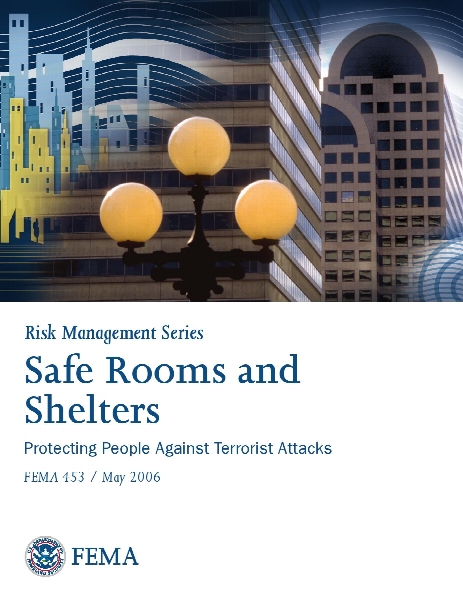Safe Rooms and Shelters, Protecting People Against Terrorists Attacks, May 2006.
- نوع فایل : کتاب
- زبان : انگلیسی
- مؤلف : United States. Federal Emergency Management Administration.
- ناشر : Homeland Security, FEMA
- چاپ و سال / کشور: 2006
- شابک / ISBN : 978-0160833694
Description
table of contents table of contents ix FOREWORD AND Acknow led gmen ts Overview............................................................................................... i Background........................................................................................ iii Scope and Organization of the Manual.............................................v Acknowledgments..............................................................................vii Chapter 1– DESIGN CONSIDERATIONS 1.1 Overview..................................................................................1-1 1.2 Potential Threats.....................................................................1-4 1.2.1 Explosive Threats.......................................................1-5 1.2.2 CBR Attacks............................................................. 1-11 1.2.2.1 Chemical Agents......................................... 1-11 1.2.2.2 Biological Warfare Agents......................... 1-12 1.2.2.3 Radiological Attacks................................... 1-13 1.3 Levels of Protection ............................................................ 1-15 1.3.1 Blast Levels of Protection....................................... 1-15 1.3.2 CBR Levels of Protection........................................ 1-17 1.4 Shelter Types........................................................................ 1-19 1.4.1 Standalone Shelters................................................ 1-19 1.4.2 Internal Shelters...................................................... 1-19 1.4.3 Shelter Categories................................................... 1-20 1.5 Siting..................................................................................... 1-23 1.6 Occupancy Duration, Toxic-free Area (TFA) . Floor Space, and Ventilation Requirements...................... 1-31 1.7 Human Factors Criteria....................................................... 1-33 1.7.1 Square Footage/Occupancy Requirements ......... 1-33 table of contents 1.7.1.1 Tornado or Short-term Shelter . Square Footage Recommendations.......... 1-34 1.7.1.2 Hurricane or Long-term Shelter. Square Footage Recommendations......... 1-35 1.7.2 Distance/Travel Time and Accessibility ............... 1-35 1.7.3 Americans with Disabilities Act (ADA).................. 1-37 1.7.4 Special Needs........................................................... 1-38 1.8 Other Design Considerations.............................................. 1-39 1.8.1 Lighting.................................................................... 1-39 1.8.2 Emergency Power.................................................... 1-39 1.8.3 Route Marking and Wayfinding ............................ 1-40 1.8.4 Signage..................................................................... 1-42 1.8.4.1 Community and Parking Signage............. 1-42 1.8.4.2 Signage at Schools and Places . of Work........................................................ 1-42 1.9 Evacuation Considerations.................................................. 1-44 1.10 Key Operations Zones.......................................................... 1-51 1.10.1 Containment Zones................................................ 1-51 1.10.2 Staging Areas and Designated Entry and . Exit Access Control Points...................................... 1-55 CH APT ER 2 – ST RUCT URAL DESIGN CRITERIA 2.1 Overview..................................................................................2-1 2.2 Explosive Threat Parameters.................................................2-1 2.2.1 Blast Effects in Low-rise Buildings............................2-5 2.2.2 Blast Effects in High-rise Buildings: . The Urban Situation..................................................2-8 2.3 Hardened Construction.........................................................2-9 table of contents xi 2.3.1 Structural System........................................................2-9 2.3.2 Loads and Connections.......................................... 2-12 2.3.3 Building Envelope................................................... 2-16 2.3.4 Forced Entry and Ballistic Resistance.................... 2-17 2.4 New Construction................................................................ 2-19 2.4.1 Structure.................................................................. 2-20 2.4.2 Façade and Internal Partitions............................... 2-26 2.5 Existing Construction: Retrofitting Considerations.......... 2-29 2.5.1 Structure.................................................................. 2-30 2.5.2 Façade and Internal Partitions............................... 2-31 2.5.2.1 Anti-shatter Façade..................................... 2-32 2.5.2.2 Façade Debris Catch Systems..................... 2-35 2.5.2.3 Internal Partitions...................................... 2-39 2.5.2.4 Structural Upgrades................................... 2-44 2.5.3 Checklist for Retrofitting Issues............................. 2-45 2.6 Shelters and Model Building Types.................................... 2-46 2.6.1 W1, W1a, and W2 Wood Light Frames . and Wood Commercial Buildings.......................... 2-46 2.6.2 S1, S2, and S3 Steel Moment Frames, . Steel Braced Frames, and Steel Light Frames....... 2-50 2.6.3 S4 and S5 Steel Frames with Concrete . Shearwalls and Infill Masonry Walls ..................... 2-54 2.6.4 C1, C2, and C3 Concrete Moment Frames, . Concrete and Infill Masonry Shearwalls – . Type 1 Bearing Walls and Type 2 Gravity . Frames...................................................................... 2-57 2.6.5 PC1 and PC2 Tilt-up Concrete Shearwalls and . Precast Concrete Frames and Shearwalls.............. 2-62 xii table of contents 2.6.6 RM1 and RM2 Reinforced Masonry Walls . with Flexible Diaphragms or Stiff Diaphragms . and Unreinforced Masonry (URM) . Load-bearing Walls.................................................. 2-65 2.6.7 Conclusions............................................................. 2-69 2.7 Case Study: Blast-Resistant Safe Room............................... 2-69 CH APT ER 3 – CBR TH REAT PROTECT ION 3.1 Overview .................................................................................3-1 3.2 How Air Filtration Affects Protection ...................................3-5 3.3 Safe Room Criteria .................................................................3-7 3.4 Design and Installation of a Toxic-agent Safe Room ...........3-9 3.4.1 Class 3 Safe Room .................................................. 3-10 3.4.1.1 Tightening the Room................................ 3-10 3.4.1.2 Preparing for Rapidly Sealing . the Room.................................................... 3-11 3.4.1.3 Preparing for Deactivation of Fans........... 3-14 3.4.1.4 Accommodating Air Conditioning . and Heating................................................ 3-14 3.4.1.5 Safety Equipment....................................... 3-16 3.4.2 Class 2 Safe Room................................................... 3-16 3.4.2.1 Filter Unit Requirements for the . Unventilated Class 2 Safe Room................ 3-16 3.4.2.2 Installation and Operation........................ 3-17 3.4.3 Class 1 Safe Room .................................................. 3-18 3.4.3.1 Selecting a Filter Unit for a Class 1 . Safe Room................................................... 3-18 3.4.3.2 Sizing the Filter Unit for . Pressurization............................................. 3-20 table of contents xiii 3.4.3.3 Other Considerations for Design of a . Class 1 Safe Room...................................... 3-21 3.5 Operations and Maintenance ............................................ 3-23 3.5.1 Operating a Safe Room in a Home ...................... 3-24 3.5.2 Operating a Safe Room in an Office Building....... 3-25 3.5.3 Operating Procedures for a Class 1 . Safe Room................................................................ 3-26 3.6 Maintaining the CBR Shelter ............................................. 3-27 3.6.1 Maintenance for a Class 3 Safe Room .................. 3-27 3.6.2 Maintenance for a Class 2 Safe Room................... 3-27 3.6.3 Maintenance for a Class 1 Safe Room .................. 3-28 3.7 Commissioning a Class 1 CBR Safe Room ........................ 3-31 3.7.1 Measurements......................................................... 3-32 3.7.2 Configuration ......................................................... 3-32 3.7.3 Functionality ........................................................... 3-33 3.8 Upgrading a CBR Safe Room ............................................. 3-34 3.9 Training on the Use of a Safe Room ................................... 3-34 3.10 Case Study: Class 1 Safe Room ........................................... 3-35 CH APT ER 4 – Emer gen cy mana gemen t con sidera tion s 4.1 Overview..................................................................................4-1 4.2 National Emergency Response Framework..........................4-1 4.3 Federal CBRE Response Teams.............................................4-9 4.4 Emergency Response........................................................... 4-11 4.4.1 General Considerations.......................................... 4-11 4.4.2 Evacuation Considerations..................................... 4-12 4.4.3 Mass Care................................................................. 4-16 xiv table of contents 4.5 Community Shelter Operations Plan................................. 4-19 4.5.1 Site Coordinator ..................................................... 4-21 4.5.2 Assistant Site Coordinator ..................................... 4-22 4.5.3 Equipment Manager .............................................. 4-22 4.5.4 Signage Manager .................................................... 4-23 4.5.5 Notification Manager ............................................. 4-24 4.5.6 Field Manager ......................................................... 4-24 4.5.7 Assistant Managers ................................................. 4-25 4.5.8 Emergency Provisions, Equipment, . and Supplies ........................................................... 4-25 4.5.8.1 Food and Water.......................................... 4-25 4.5.8.2 Sanitation Management............................. 4-25 4.5.8.3 Emergency Supplies................................... 4-28 4.5.8.4 Communications Equipment.................... 4-28 4.5.8.5 Masks and Escape Hoods........................... 4-29 4.5.8.6 Portable HVAC Units................................. 4-29 4.5.8.7 Emergency Equipment Credenza . and Wall Units Storage.............................. 4-30 4.6 Shelter Maintenance Plan................................................... 4-30 4.7 Commercial Building Shelter Operations Plan................. 4-30 4.7.1 Emergency Assignments......................................... 4-31 4.7.2 Emergency Call List................................................ 4-33 4.7.3 Event Safety Procedures......................................... 4-34 4.8 General Considerations....................................................... 4-34 4.9 Training and Information................................................... 4-36


